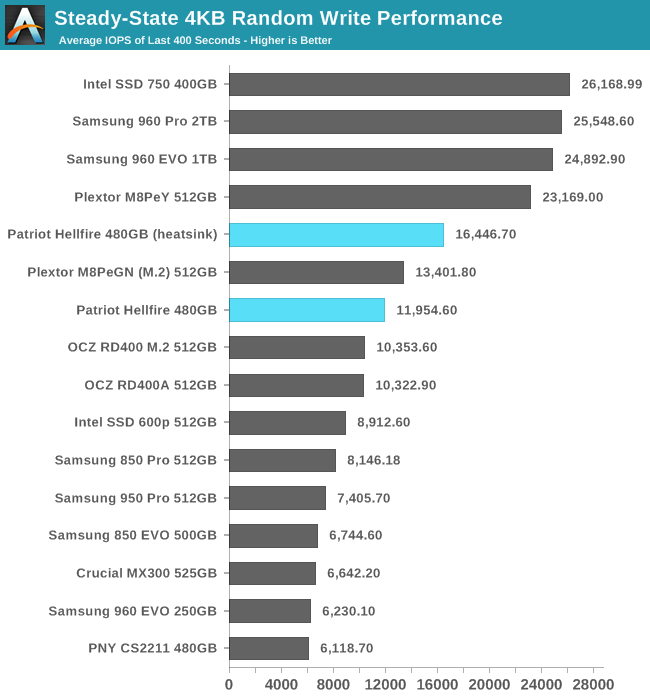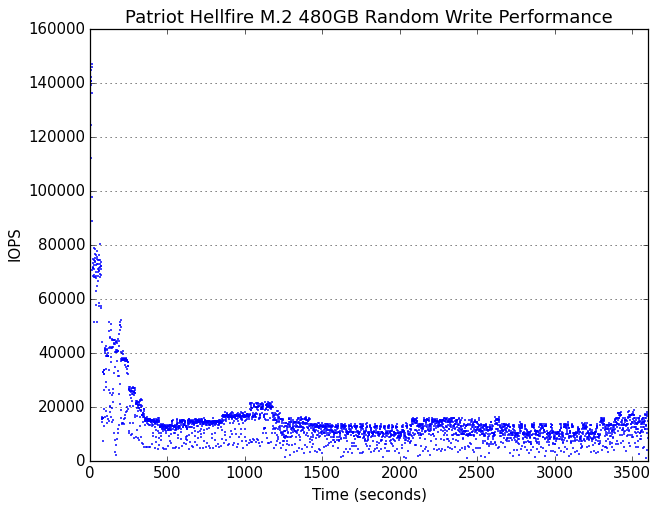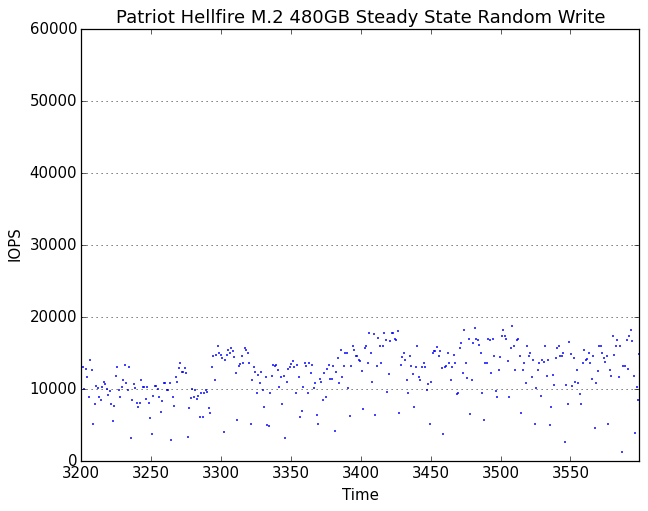The Patriot Hellfire M.2 480GB Review: Phison NVMe Tested
by Billy Tallis on February 10, 2017 8:30 AM ESTPerformance Consistency
Our performance consistency test explores the extent to which a drive can reliably sustain performance during a long-duration random write test. Specifications for consumer drives typically list peak performance numbers only attainable in ideal conditions. The performance in a worst-case scenario can be drastically different as over the course of a long test drives can run out of spare area, have to start performing garbage collection, and sometimes even reach power or thermal limits.
In addition to an overall decline in performance, a long test can show patterns in how performance varies on shorter timescales. Some drives will exhibit very little variance in performance from second to second, while others will show massive drops in performance during each garbage collection cycle but otherwise maintain good performance, and others show constantly wide variance. If a drive periodically slows to hard drive levels of performance, it may feel slow to use even if its overall average performance is very high.
To maximally stress the drive's controller and force it to perform garbage collection and wear leveling, this test conducts 4kB random writes with a queue depth of 32. The drive is filled before the start of the test, and the test duration is one hour. Any spare area will be exhausted early in the test and by the end of the hour even the largest drives with the most overprovisioning will have reached a steady state. We use the last 400 seconds of the test to score the drive both on steady-state average writes per second and on its performance divided by the standard deviation.

The Patriot Hellfire maintains a higher average random write speed than the significantly more expensive OCZ RD400 and the older Samsung 950 PRO, but the Plextor M8Pe performs even better, especially when heatsinks are used.

The Patriot Hellfire does not have the very high consistency of the Intel SSD 750 or most of Samsung's SSDs, but the score is not worryingly low. For consumer-oriented products, consistency under sustained write load is generally a lower priority than high burst performance and quick recovery during idle times.
 |
|||||||||
| Default | |||||||||
| 25% Over-Provisioning | |||||||||
The Patriot Hellfire shows some long-term fluctuations in random write performance, especially when equipped with a heatsink to allow for higher peak performance. With extra overprovisioning, the long-term trend is very stable and the effect of the heatsink is greatly reduced.
 |
|||||||||
| Default | |||||||||
| 25% Over-Provisioning | |||||||||
On shorter time scales, the Patriot Hellfire is never particularly consistent. Adding a heatsink increases the peak performance but only helps the minimums slightly. Adding extra overprovisioning greatly increases the amount of time spent operating at or near peak performance, but does not entirely eliminate the drops down below 5k IOPS.










43 Comments
View All Comments
lilmoe - Friday, February 10, 2017 - link
It's sad that all these non-Samsung MLC NVMe SSDs can't even compete with the TLC 960 Evo... But then again, which has more endurance? VNAND TLC or 15nm MLC?bug77 - Friday, February 10, 2017 - link
V-NAND TLC has about the same number of p/e cycles as planar MLC.Bullwinkle J Moose - Friday, February 10, 2017 - link
"Which has more endurance" is a false choice!You need to specify Brand, Process, Controller and Firmware Version when comparing endurance
Mixing MLC and TLC also does not help in the least
I pay less over time for a better process like 40nm Samsung MLC than I do for a cheaper process like 15nm Toshiba MLC, even though the initial cost of the Samsung is higher
Likewise, you should only compare TLC with TLC
The only Non-Endurance issue I've ever had with 3D V-Nand is that I had to update Acronis True Image from the 2012 version to 2015/16 or 17 so the backups would restore correctly
guidryp - Friday, February 17, 2017 - link
That makes no sense.MLC has more endurance than TLC.
Adding more layers to TLC doesn't improve endurance.
lilmoe - Monday, February 20, 2017 - link
That's 40nm TLC vs 15nm MLC... I'd vouch for Samsung's process, and vertically integrated product.bogdan.anghel1986 - Friday, February 17, 2017 - link
can't even compete? this SSD is priced about the same with a 850 EVO SATA3, and a lot faster. try not to compare it with other SSD's that cost double. in reviews they put it up against the best so you can have an ideea where it sits.do you compare a Lamborghini with a VW Polo ?
lilmoe - Monday, February 20, 2017 - link
You call 20$ a difference for NVMe drives? Really? Lambos cost 20 times more than Polos, the heck is wrong with you?Arbie - Friday, February 10, 2017 - link
"Hellfire" - for a disk drive? If I buy this, I'd be promoting stupid naming. There's a point in such things where the prospective customer is simply being insulted. Hard to define, but "I know it when I see it".Murloc - Friday, February 10, 2017 - link
Everybody has a naming scheme. What's wrong with copying names already used by weapons, for a company named patriot?Hellfire sounds stupid but other missile names aren't much better, or they're boring.
BrokenCrayons - Friday, February 10, 2017 - link
Well, have a nap and then FIRE ZE MISSILES!!!